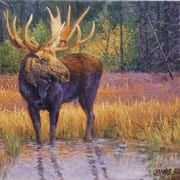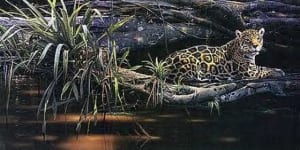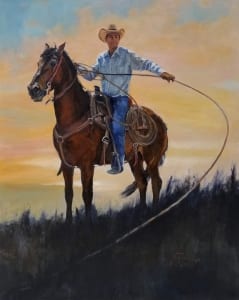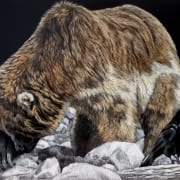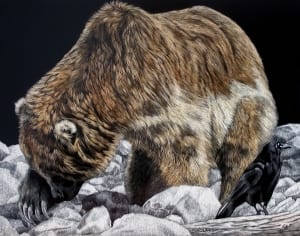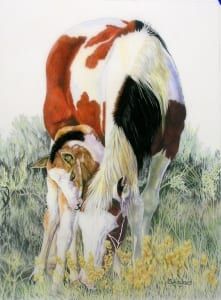Winter Hawk — Beaded Jewelry by Tamara Reily

In Native American culture, the horse represents strength, passion, and great energy. The color of the horse, also, plays a big role in its meaning. Buckskin and Appaloosa Horse Beaded Sun Catchers by Tamara Reily
Whether or not you like winter doesn’t change the weather. What does change is how you feel about it.
And while many people groan about the cold, the long nights, the snow that makes driving difficult, Tamara Reily rejoices in the season.
“I named my business Winter Hawk because I enjoy winter time,” the Dayton, WA, bead and leather artist says.
“I love the cold crisp mornings when the frost hangs thick in the air, and the earth mother is blanketed in a white winter coat of snow. It reminds me of Alaska and all the time I spent outdoors running my dog team, exploring the frozen white wilderness that surrounded our home.
“I always have a sense of contentment while being outdoors in the wintertime.”

The Snowy Owl represents spiritual growth, a deep change releasing a lower state of being and embracing a higher purpose. Snowy Owl Beaded Necklace by Tamara Reily.
Reily, whose heritage includes Pawnee, a Native American people who historically lived in what are now Nebraska and Kansas and later Oklahoma, also connects with the red-tailed hawk, which she says she knows as a brother.
“I love to watch the hawk fly above me high in the sky while I sit upon the earth mother. Whenever my heart is burdened with the stress life brings he flies out from the woods, finds me in my time of need. Just watching Hawk fly in circles and dip and dive takes my mind to another place, a place of peace.”
Many Animals — Much Symbolism
Another place Reily finds a sense of peace is her studio, where she creates bead and leatherwork art drawing upon the symbolism of not only the Pawnee people, but many other Native American groups of North America. In addition to fashioning numerous types of bags (medicine, gathering, pipe, tobacco) which we focused on in an earlier article, Finessing Ancient Skills in a Modern World, Reily also designs and makes necklaces, bracelets, and earrings incorporating the rich symbolism of Native American culture.
“The many animal patterns that I bead have certain symbolisms. I enjoy sharing what they are to help people learn and understand Native cultures.
“For example, there is the Snowy Owl, which represents spiritual growth. Seeing Snowy Owl represents deep change resulting in the releasing of a lower state of being and embracing your higher purpose.
“The Grey Wolf represents loyalty and success. It is powerful, and heals humans who are sick. Grey Wolf is also a teacher, pathfinder, and survivalist.
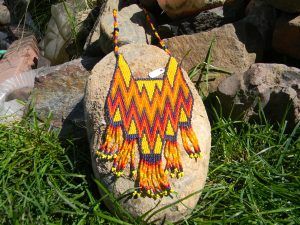
The Sunrise Necklace incorporates the colors of dawn, which warm both summer and winter. By Tamara Reily
“The Tlingit (pronounced Klinket) Bear, as a spirit totem, as a power animal, can help teach you to trust your instincts and let go.
“And then there is the Horse, which symbolizes strength, passion, and great energy. In the Native American culture they also represent wealth and power.
“You will see a lot of my necklaces and patches with these animal totems on them.”
Winter Mountain Snow
Raised in Walla Walla, Reily has somehow or another managed to live in or near the mountains with appreciable winter snow. Years ago, she raised her children in the Yaak, a remote area of Montana, where she also began seriously beading (“working under lantern light as the long winters came and went”). From there she moved to Alaska to become a recreational dog musher, spending many winter nights running through the Alaska wilderness while the Northern Lights danced above her head.

The beaded Tlingit Bear Necklace honors the bear, a teacher who is often misunderstood. Bear is friendly, a symbol of strength learned, humility, and motherhood. By Tamara Reily
And in Dayton, in that studio of refuge, she surrounds herself with a “chaotic, creative mess.
“My studio is a small bedroom in the back of the house, where I put a small rolltop desk in a corner of the room. It has lots of drawers to put my treasures I have collected for years to use in my artwork.
“The beads I’m using for a project are spread all over the desk. Piles of leather and containers of crow beads and wampum sit near the desk. Drawers and containers of beads are in every nook and cranny of the desk. Even a few of my favorite rocks sit atop the desk.”
Every piece she creates has meaning, Reily says. And every piece represents a proud people whose culture should be remembered and honored.
Honoring a Proud People
“My people who passed on before me were from the Pawnee tribe, and making items from this tribe makes my heart happy.
“My pride for the Native Americans shows in my many items I make or bead.”
And although the winters of Dayton are milder than what Reily encountered in Montana or Alaska, it is the perfect place for doing what she does now, regardless of the season. All year round she beads. In the spring she sets up a tipi in her yard and invites people from throughout the area to gather and talk, teach, and share each other’s culture with one another. And every day, in every season, she finds opportunity to appreciate life, breath, and earth.
“Touch Mother Earth as much as you can. The soil is where we came from, and it is where we will go.
“We are a part of all things.”
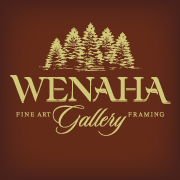 Tamara Reily is the featured 3D Art Event at Wenaha Gallery from February 1, 2022 through February 28. Her 2D work, which includes leather and beadwork bags, is featured through February 14.
Tamara Reily is the featured 3D Art Event at Wenaha Gallery from February 1, 2022 through February 28. Her 2D work, which includes leather and beadwork bags, is featured through February 14.
Contact the gallery, located at 219 East Main Street, Dayton, WA, by phone at 509.382.2124 or e-mail art@wenaha.com. Gallery hours are 9 a.m. to 5 p.m. from Monday through Friday, and by appointment. Visit the Wenaha Gallery website online at www.wenaha.com.







